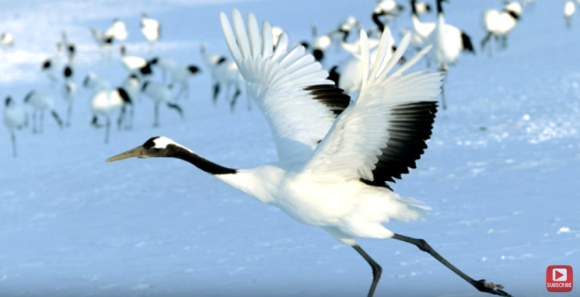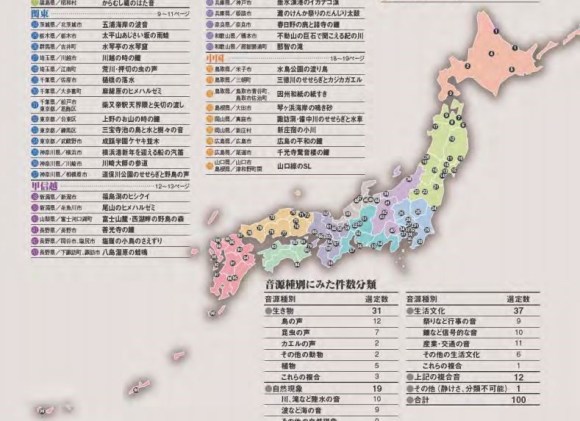
“The 100 what??” That was our initial reaction too, but the official list is just what it sounds like!
Many of you know at least a few famous natural landscapes or must-see places scattered throughout Japan, such as the government-designated Places of Scenic Beauty or the UNESCO World Heritage Sites. But how many of you are familiar with the 100 Soundscapes of Japan?
The term “soundscape” might sound strange, but it’s meant to be an equivalent of the term “landscape”–like candy for your ears. In 1996, Japan’s Ministry of the Environment actually designated 100 symbolic phenomena throughout the country as official Soundscapes of Japan in an effort to both preserve those sounds for future generations to come and to combat noise pollution. The 100 phenomena were chosen from 738 entries by the Japan Soundscape Study Group (yes, a real entity), and span the entire length of the island nation, from the northernmost island of Hokkaido to the southern islands of Okinawa.
▼ A visual map of all 100 soundscapes across Japan
Furthermore, the list includes not only natural world soundscapes covering all four seasons, but also soundscapes of important intangible Japanese cultural artifacts and regional trades. In other words, there’s more than just the quintessential Japanese summer buzzing of cicadas or the gushing of waterfalls; the memorable sounds of a fair number of Japanese festivals and traditional handcrafts being produced are also included!
Below, we’ve gathered a mixed sampling of fifteen of the soundscapes for your viewing aural pleasure. Enjoy!
▼ Soundscape #1: Drift ice in the Sea of Okhotsk (Hokkaido)
▼ Soundscape #5: Japanese crane sanctuary, Tsurui (Hokkaido)
▼ Soundscape #12: Bells of Chagu Chagu Umakko Festival (Iwate Prefecture) (skip to 7:20)
This horse festival held every June was designated an Intangible Folk Cultural Property by the Japanese government Chagu chagu is onomatopoeia for the sound of the bells fitted onto the horses’ colorful decorations.
▼ Soundscape #18: Cicadas at Yamadera (Yamagata Prefecture)
Haiku master Matsuo Basho (1644-1694) composed this famous poem at Yamadera: Stillness / Seeping into rocks / A cicada’s cry
▼ Soundscape #23: Weaving of ramie fabric (Fukushima Prefecture) (skip to 4:40)
Fukushima Prefecture’s Showa Village is renowned for the centuries-old handcraft of weaving ramie textiles, known as karamushi-ori in Japanese.
▼ Soundscape #35: Ship whistles for the New Year at Yokohama Port (Kanagawa Prefecture)
▼ Soundscape #48: Isobue whistling of female divers in Ise-Shima area (Mie Prefecture) (skip to 2:30)
▼ Soundscape #52: Shomyo Falls (Toyama Prefecture)
▼ Soundscape #62: Squeaking sand of Kotobikihama Beach (Kyoto Prefecture)
This beach is one of the few places in Japan where the sand makes a unique “singing” sound when you walk on it.
▼ Soundscape #71: Mitoku River and singing frogs (Tottori Prefecture)
▼ Soundscape #76: Bell of Peace in Hiroshima (Hiroshima Prefecture)
▼ Soundscape #79: Naruto whirlpools (Tokushima Prefecture)
▼ Soundscape #80: Awa Odori Festival (Tokushima Prefecture)
This summer festival is the largest dance festival in Japan. Awa refers to the former feudal administrative region of Tokushima, and odori means dance.
▼ Soundscape #89: Imari Pottery (Saga Prefecture) (skip to 19:20)
Imari porcelain, also known as Arita porcelain, is a type of pottery that was particularly popular with Europeans in the second half of the 17th century.
▼ Soundscape #100: Eisa Festival (Okinawa Prefecture)
Eisa is a type of Okinawan folk dance performed in lines or circles to the accompaniment of singing, chanting, and drumming.
If you enjoyed the entries above and want to read the full list, Japan’s Ministry of the Environment provides a free pamphlet download with detailed descriptions of all 100 of the soundscapes (Japanese only). Happy sound hunting, everyone!
Sources: Wikipedia (English), Wikipedia (Japanese)
Top image: YouTube/Soul Candle
Insert image: Japan Ministry of the Environment


 Five uninhabited Japanese islands you can buy right now
Five uninhabited Japanese islands you can buy right now Wagakki Band release music video for “Valkyrie”, opening song for Twin Star Exorcists anime
Wagakki Band release music video for “Valkyrie”, opening song for Twin Star Exorcists anime This Year of the Rabbit, visit some of the best Japanese sightseeing spots related to rabbits
This Year of the Rabbit, visit some of the best Japanese sightseeing spots related to rabbits Japan’s Top 7 alternative “Regional Burgers”
Japan’s Top 7 alternative “Regional Burgers” Where will you go this summer? Here are the top 10 Japanese swimming spots with the nicest water
Where will you go this summer? Here are the top 10 Japanese swimming spots with the nicest water McDonald’s new Happy Meals offer up cute and practical Sanrio lifestyle goods
McDonald’s new Happy Meals offer up cute and practical Sanrio lifestyle goods All-you-can-drink Starbucks and amazing views part of Tokyo’s new 170 meter-high sky lounge
All-you-can-drink Starbucks and amazing views part of Tokyo’s new 170 meter-high sky lounge Studio Ghibli glasses cases let anime characters keep an eye on your spectacles
Studio Ghibli glasses cases let anime characters keep an eye on your spectacles Kyoto’s 100 Demons yokai monster parade returns!
Kyoto’s 100 Demons yokai monster parade returns! Super Nintendo World expansion gets delayed for several months at Universal Studios Japan
Super Nintendo World expansion gets delayed for several months at Universal Studios Japan Arrest proves a common Japanese saying about apologies and police
Arrest proves a common Japanese saying about apologies and police Beautiful Sailor Moon manhole cover coasters being given out for free by Tokyo tourist center
Beautiful Sailor Moon manhole cover coasters being given out for free by Tokyo tourist center More foreign tourists than ever before in history visited Japan last month
More foreign tourists than ever before in history visited Japan last month The oldest tunnel in Japan is believed to be haunted, and strange things happen when we go there
The oldest tunnel in Japan is believed to be haunted, and strange things happen when we go there Princesses, fruits, and blacksmiths: Study reveals the 30 most unusual family names in Japan
Princesses, fruits, and blacksmiths: Study reveals the 30 most unusual family names in Japan Disney princesses get official manga makeovers for Manga Princess Cafe opening in Tokyo
Disney princesses get official manga makeovers for Manga Princess Cafe opening in Tokyo Starbucks reopens at Shibuya Scramble Crossing with new look and design concept
Starbucks reopens at Shibuya Scramble Crossing with new look and design concept Beautiful new Final Fantasy T-shirt collection on the way from Uniqlo【Photos】
Beautiful new Final Fantasy T-shirt collection on the way from Uniqlo【Photos】 Is the new Shinkansen Train Desk ticket worth it?
Is the new Shinkansen Train Desk ticket worth it? Foreign English teachers in Japan pick their favorite Japanese-language phrases【Survey】
Foreign English teachers in Japan pick their favorite Japanese-language phrases【Survey】 Japanese convenience store packs a whole bento into an onigiri rice ball
Japanese convenience store packs a whole bento into an onigiri rice ball We try out “Chan Ramen”, an underground type of ramen popular in the ramen community
We try out “Chan Ramen”, an underground type of ramen popular in the ramen community Studio Ghibli releases Kiki’s Delivery Service chocolate cake pouches in Japan
Studio Ghibli releases Kiki’s Delivery Service chocolate cake pouches in Japan Japan’s bone-breaking and record-breaking roller coaster is permanently shutting down
Japan’s bone-breaking and record-breaking roller coaster is permanently shutting down New definition of “Japanese whiskey” goes into effect to prevent fakes from fooling overseas buyers
New definition of “Japanese whiskey” goes into effect to prevent fakes from fooling overseas buyers Our Japanese reporter visits Costco in the U.S., finds super American and very Japanese things
Our Japanese reporter visits Costco in the U.S., finds super American and very Japanese things Studio Ghibli unveils Mother’s Day gift set that captures the love in My Neighbour Totoro
Studio Ghibli unveils Mother’s Day gift set that captures the love in My Neighbour Totoro Foreign passenger shoves conductor on one of the last full runs for Japan’s Thunderbird train
Foreign passenger shoves conductor on one of the last full runs for Japan’s Thunderbird train Domino’s Japan now sells…pizza ears?
Domino’s Japan now sells…pizza ears? New Japanese KitKat flavour stars Sanrio characters, including Hello Kitty
New Japanese KitKat flavour stars Sanrio characters, including Hello Kitty Kyoto creates new for-tourist buses to address overtourism with higher prices, faster rides
Kyoto creates new for-tourist buses to address overtourism with higher prices, faster rides Sales of Japan’s most convenient train ticket/shopping payment cards suspended indefinitely
Sales of Japan’s most convenient train ticket/shopping payment cards suspended indefinitely Sold-out Studio Ghibli desktop humidifiers are back so Totoro can help you through the dry season
Sold-out Studio Ghibli desktop humidifiers are back so Totoro can help you through the dry season Japanese government to make first change to romanization spelling rules since the 1950s
Japanese government to make first change to romanization spelling rules since the 1950s Ghibli founders Toshio Suzuki and Hayao Miyazaki contribute to Japanese whisky Totoro label design
Ghibli founders Toshio Suzuki and Hayao Miyazaki contribute to Japanese whisky Totoro label design Doraemon found buried at sea as scene from 1993 anime becomes real life【Photos】
Doraemon found buried at sea as scene from 1993 anime becomes real life【Photos】 Tokyo’s most famous Starbucks is closed
Tokyo’s most famous Starbucks is closed One Piece characters’ nationalities revealed, but fans have mixed opinions
One Piece characters’ nationalities revealed, but fans have mixed opinions We asked a Uniqlo employee what four things we should buy and their suggestions didn’t disappoint
We asked a Uniqlo employee what four things we should buy and their suggestions didn’t disappoint Japan’s random-destination roll-the-die train tickets: An amazingly cheap way to go…somewhere
Japan’s random-destination roll-the-die train tickets: An amazingly cheap way to go…somewhere Top 10 places to see a spectacular sunset in Japan
Top 10 places to see a spectacular sunset in Japan Aomori’s fabled Nebuta Festival 2015 to feature Star Wars floats
Aomori’s fabled Nebuta Festival 2015 to feature Star Wars floats 100 things to do in Japan in 100 seconds 【Video】
100 things to do in Japan in 100 seconds 【Video】 Win a room or bed on an overnight boat from Nagoya in ferry’s Boat Gacha campaign
Win a room or bed on an overnight boat from Nagoya in ferry’s Boat Gacha campaign The 10 best hotel hot springs in Japan, as chosen by Japanese travelers
The 10 best hotel hot springs in Japan, as chosen by Japanese travelers The top five places to survive a real attack by Titans in Japan
The top five places to survive a real attack by Titans in Japan We roll the die on Japan’s new random-destination train tickets
We roll the die on Japan’s new random-destination train tickets Japan petitions to add 40 traditional folk dances to UNESCO’s Intangible Cultural Heritage list
Japan petitions to add 40 traditional folk dances to UNESCO’s Intangible Cultural Heritage list Five words that sound completely different across Japanese regional dialects
Five words that sound completely different across Japanese regional dialects Job Buddhas and paper hand jobs: Thai government’s list of jobs foreigners may not do is amazing
Job Buddhas and paper hand jobs: Thai government’s list of jobs foreigners may not do is amazing Love Ghibli’s Castle in the Sky? Check out these real Laputa-like locations!
Love Ghibli’s Castle in the Sky? Check out these real Laputa-like locations! The top 10 hot springs Japanese travelers want to visit this fall
The top 10 hot springs Japanese travelers want to visit this fall Soak in a sand bath in Beppu, Japan’s famous onsen region
Soak in a sand bath in Beppu, Japan’s famous onsen region Airbnb listing in Japan reveals travel destination with exclusive use of huge private island
Airbnb listing in Japan reveals travel destination with exclusive use of huge private island Fanmade “Pokémon Uranium” is a full-length Pokémon game available for free download now!
Fanmade “Pokémon Uranium” is a full-length Pokémon game available for free download now!
Leave a Reply